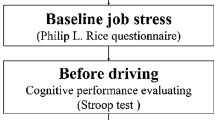Abstract
Purpose
The present work aims to study the effects of whole body vibration (WBV) on bus fare collectors through the use of cognitive tests. It is of interest for all individuals working as bus fare collectors or any other activity where logic is of paramount importance and that is performed on a vibrating environment.
Methods
Laboratory simulations were performed in 24 volunteers employing a vibrating platform subjected to vertical vibration. The influence of WBV on cognition was assessed using the performance on a logic game. The frequencies used were 5 Hz and 30 Hz. The acceleration amplitude values were set up as 0.7 m/s2 and 0.2 m/s2. A daily commute was simulated, based on data of the public transport system in the city of Belo Horizonte. A vibration-free test was initially performed to serve as a basis for comparison.
Results
The data obtained in all situations were compared and statistically analyzed. At 5 Hz, variation only shows significant after 5 min of vibration ceased as if the residual effect had passed after 5 min of rest. The gender variable was not significant. However, the older the volunteer, the worse the performance. Regarding 30 Hz frequency, the hypotheses did not meet the condition of significance at 5% but showed an opposite tendency indicating, in this situation, a score increase. It is noticed that the female volunteers presented a better performance in relation to the male gender The residual effect lasts for less than 10 min for short exposure intervals, since the score of test 8, in 5 Hz and 30 Hz, show a reduction of performance.
Conclusions
From the results, it was possible to conclude that the frequency of 5 Hz may be related to reduced performance for long exposure times while the 30 Hz frequency has positive effects on cognition as the exposure time increases. In fact, it is a tendency much more than a clear statistical finding. Regarding comfort, most reports related to the frequency of 5 Hz are linked to the sensation of discomfort and difficulty in focusing visually, whereas, for the frequency of 30 Hz, the reports indicate a feeling of muscular comfort and increased easiness of concentration.





Similar content being viewed by others

Availability of data and material
Data may become available under request.
References
Assunção AA, Silva SL (2013) Working Conditions on public buses and common mental disorders in drivers and bus fare collectors: greater metropolitan Belo Horizonte, Minas Gerais State, Brazil, 2012 (in Portuguese). Cad Saúde Públ 29:12. https://doi.org/10.1590/0102-311X00181412
Balbinot A (2001) Characterization of vibration levels in bus drivers: an approach to comfort and health (in Portuguese). In: D.Sc. Thesis, Porto Alegre/RS
Bellman MA (1972) Perception of whole body vibration: from basic experiments to effects of seat and steering wheel vibration on the passenger´s comfort inside vehicles. In: Ph.D. Thesis, Universit Oldenburg zur Erlangung des Grades Eines
Belo Horizonte City Hall MS (2012) Acesso em 01 de Jun de 2017, disponível em Belo Horizonte Neighborhoods (in Portuguese). https://bairrosdebelohorizonte.webnode.com.br/avenidas-e-ruas-de-bh-/
Boerema AS, Heersterbeek M, Boersma SA, Shoemaker R, de Vries EF, Van Heuvelen MJ, Van der Zee EA (2018) Beneficial effects of whole body vibration on brain functions in mice and humans. Dose-Response Int J. https://doi.org/10.1177/1559325818811756
Chaffin DB, Andersson GB, Martin BJ (1999) Occupational Biomechanics. Wiley-Interscience, USA
Donadon L, Duarte M, Galvez J (2012) Development of an active control system for a whole body vibration platform. ABCM Symp Ser Mechatron 5:298–305
Figueiredo M, Silva LF, Barnabé TL (2016) Collective transport: whole-body vibration and comfort of passengers, drivers and bus fare collectors (in Portuguese). In: IT Society (eds) Journal of transport literature, vol 1, pp 35–39. https://kopernio.com/viewer?doi=10.1590/2238-1031.jtl.v10n1a7&route=6
Firmino SG (2017) Influence of whole body vibration on bus bus fare collectors evaluated by means of cognition tests (in Portuguese). In: Final year project essay, universidade federal de Minas Gerais (UFMG), Mechanical Engineering Department (DEMEC), Belo Horizonte
Fuermaier AB, Tucha L, Koerts J, Van Heuvelen MJ, Van Der Zee EA (2014) Good vibrations—effects of whole body vibration on attention in healthy individuals and individuals with ADHD. PLoS ONE 9:2. https://doi.org/10.1371/journal.pone.0090747
Griffin M (1996) Handbook of human vibration. Academic Press, Hoboken
IDEC BI (2013) Average distance between bus stops in Belo Horizonte (in Portuguese). https://www.otempo.com.br/usu%C3%A1rio-anda-at%C3%A9-744-m-para-chegar-aos-pontos-de-%C3%B4nibus-1.709850. Accessed 1 Jun 2017
Jiang J (2007) Linear and generalized linear mixed models and their applications (S Statistics Ed.). Springer, New York
Liang C-C, Chiang C-F (2006) A stuy on biodynamic models of seated human subjects exposed to vertical vibration. Intern J Ind Ergon 2006:869–890
Mansfield N (2005) Human response to vibration. Springer, New York
Newell GS, Mansfield NJ (2008) Evaluation of reaction time performance and subjective workload during whole-body vibration exposure while seated in upright and twisted postures with and without armrest. Int J Ind Ergon 5–6:499–508. www.sciencedirect.com/science/article/pii/S0169814107001679
Nick HC, Duarte MM, Xavier PV (2019) The effects of whole-body vibration (WBV) evaluated using cognitive brain-training app games on tablet or cell phone for both genders. Augmented Hum Res. https://doi.org/10.1007/s41133-019-0015-4
Park DJ, Choi MG, Song JT, Ahn SJ, Jeong WB (2019) Attention decrease of drivers exposed to vibration from military vehicles when driving in terrain conditions. Int J Ind Ergon 2019:363–371. https://doi.org/10.1016/j.ergon.2019.06.014
Regterschot GR, Van Heuvelen MJ, Zeinstra EB, Fuermaier AB, Tucha L, Koerts J, Van Der Zee EA (2014) Whole body vibration improves cognition in healthy young adults. PLoS ONE 9:6
Rosetta Stone Canada Inc (2013) Fit brains. https://www.microsoft.com/pt-br/p/fit-brains-trainer/9nblggh10xhb?activetab=pivot%3aoverviewtab
Acknowledgements
The authors are most thankful to Dr. Conny Lin who made the work possible with the help of Rosetta Stone.
Funding
The research developed in this work was partially funded by FAPEMIG (Fundação de Amparo a Pesquisa do Estado de Minas Gerais—Research Foundation of the Minas Gerais State) by means of a scholarship given to one of the authors.
Author information
Authors and Affiliations
Contributions
All authors have contributed to the work either making the experiments, analysis or contributing to the written text.
Corresponding author
Ethics declarations
Conflict of interest
The authors declare that they have no conflict of interest.
Ethical approval
CAAE 55602816.4.0000.5149.
Additional information
Publisher's Note
Springer Nature remains neutral with regard to jurisdictional claims in published maps and institutional affiliations.
Rights and permissions
About this article
Cite this article
Firmino, S.G., Duarte, M.L.M., Neves, J.A.B. et al. Whole body vibration influence on bus fare collectors evaluated by using a brain training mobile app. Int Arch Occup Environ Health 94, 495–501 (2021). https://doi.org/10.1007/s00420-020-01601-x
Received:
Accepted:
Published:
Issue Date:
DOI: https://doi.org/10.1007/s00420-020-01601-x



